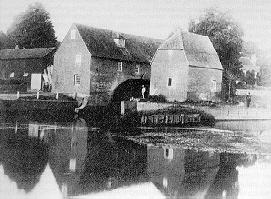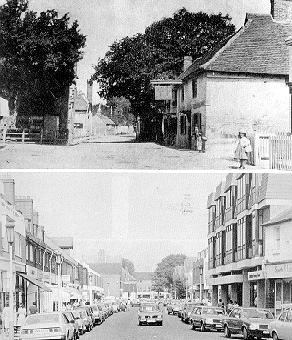|
Cobham is a Surrey Town 10 minutes from the edge of London on the fast A3, 35 minutes from Central London by train and linked to both London's International Heathrow and Gatwick Airports by London's Orbital M25 motorway. Yet Cobham is surrounded by beautiful countryside and many National Treasures including Painshill Park and the Royal Horticultural Gardens at Wisley.
Although Cobham is close to London, it has managed to retain a distinctive identity helped by the extensive commons which surround it on all sides.
It is an ancient settlement whose origins can be traced back through Roman times to the Iron Age. A Bronze age burial urn found at Leigh Hill is shown in the photograph. At the time of the Domesday Book (1086) it was known as Coveham or Covenham which is thought to mean a settlement in the curve of a river.

The Cobham Mill c1890
The river Mole, a tributary of the Thames, almost encircles Cobham and provides a distinctly rural appearance in some places. The river provides a setting for Cobham's best-known landmark which is the red brick water mill which dates from the early 19th century and which stands on the site of earlier mills dating back to the middle ages. Recently restored to full working order, the mill is probably unique in Surrey and is open to the public on certain days of the month.
Opposite the Mill is the Cedar House Restaurant and Hotel, a delightful old property owned by the National Trust.
The ancient parish of Cobham originally included part of what is now the village of Oxshott with its well-known heath. Downside is a small hamlet to the south of Cobham with a delightful collection of houses and a pub around its large village green. Next to Cobham is Stoke d'Abernon which takes its name from a family who came over at the time of the Norman conquest in 1066. Its ancient parish church contains some of the oldest monumental brasses in the country. Nowadays the Manor House houses Parkside School. Nearby is the world-famous Yehudi Menuhin School.
There are a number of attractions in the vicinity of Cobham. To the south, on Chatley Heath, is the recently restored Semaphore Tower. This was built in the 1820s as part of a line of similar buildings so that messages could be relayed between the Admiralty in London and the Naval Dockyard at Portsmouth.
The chief attraction for visitors to Cobham is the magnificent Painshill Park which is considered to be amongst the finest eighteenth century landscape gardens to be found in the United Kingdom. It is one of the great gardens of Europe and can be visited on open days during the week.
Other famous gardens to be found nearby are those of the Royal Horticultural Society at Wisley and the National Trust's Claremont Landscape Garden between Cobham and Esher.
Cobham's history can be explored further at the newly refurbished Elmbridge Museum in Weybridge, as well as at the Guildford Museum.
Nowadays, Cobham is primarily a residential area with easy access to the M25 Orbital Motorway which provides a good link with both London Heathrow and London Gatwick Airports. There is also a a regular train service to London (Waterloo) which in turn, has a frequent service by Eurostar to Paris and Brussels.
There are excellent schools in the area including St. Andrew's Church of England Primary School, Reeds School, Feltonfleet, Notre Dame and the American Community School on the Fairmile.
Anglican, Roman Catholic, Methodist, United Reformed and Brethren Churches can be found in Cobham which is also the home of Pioneer People, a church in the community currently meeting in the Cannon Cinema at Esher.
A new Cottage Hospital and Health Centre have recently been opened and there is a lively Day Centre for the elderly in the centre of the town.
A wide range of shops can be found in the centre of Cobham with good parking nearby.
Nineteenth Century Cobham High Street

Twentieth Century Cobham High Street
|